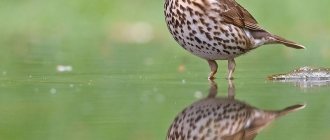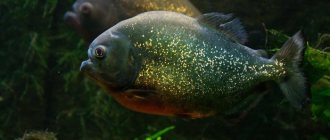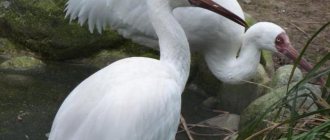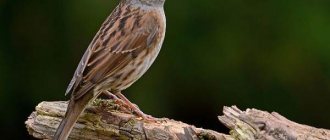Orioles are medium-sized birds that nest in trees. Males have bright plumage, females are duller.
Orioles live in forests all year round, and spend most of their time in the canopy of tall trees. The birds build a beautiful bowl-shaped nest of woven grasses, where the chicks are raised by both parents.
The oriole is a cute bird in appearance and its singing is melodious.
Description of the oriole
- body length up to 25 cm;
- wingspan up to 47 cm;
- weighs no more than 70 grams.
An adult male has a golden yellow head, upper and lower body. The wings are black with broad yellowish areas forming carpal patches on the folded wings, and a yellow crescent in flight. Flight feathers have narrow, pale yellowish tips. The tail is black, with many yellow dots on the lower part of the large feathers. The yellow head has black markings near the eyes and a dark pink beak. The eyes are dark burgundy or red-brown. The legs and feet are grey-blue.
Oriole diet
The common oriole can feed not only on fresh plant food, but also on very highly nutritious food of animal origin. During the period of mass ripening of fruits, birds willingly eat them and the berries of such crops as bird cherry and currants, grapes and cherries. Adult orioles prefer pears and figs.
The active breeding season coincides with the supplementation of the birds’ diet with all kinds of animal food, represented by:
- wood insects in the form of various caterpillars;
- long-legged mosquitoes;
- earwigs;
- relatively large dragonflies;
- various butterflies;
- wood bugs;
- forest and garden bugs;
- some spiders.
Occasionally, orioles destroy the nests of small birds, including redstarts and gray flycatchers. As a rule, representatives of the oriole family feed in the morning, but sometimes this process can drag on until lunch.
How does a female oriole differ from a male and young animals?
An adult female has a greenish-yellow head, neck, mantle and back, and a yellowish rump. The wings are green to brownish in color. The tail is brownish-black with yellowish spots on the tips of the feathers.
The underparts of the chin, throat and upper chest are pale grey, and the belly is yellowish-white. The lower part of the body has dark stripes, they are most noticeable on the chest. The plumage at the bottom of the tail is yellow-green.
Older females are similar to males, but their color is dull yellow with indistinct veining on the lower parts of the body.
Juvenile orioles resemble females with dull colored upperparts and striped underparts.
Female and male oriole
Listen to the voice of the oriole
Orioles return to their homeland late, towards the end of April or May, and the males arrive earlier than the females. After their return, the pairing begins. Orioles love birch and oak forests with a dry climate, in which they build their nests. Sometimes the homes of these birds can be found in pine or mixed forests, gardens or thickets on the banks of rivers. The height of the nest is from 7 to 15 meters.
By the end of May - beginning of June, a clutch occurs, in which there are 4-5 eggs, painted white with small black or brownish-brown spots of irregular shape. The chicks are incubated exclusively by the female. After 2 weeks of incubation, the chicks begin to hatch. After another 2-2.5 weeks they leave the nest.
The oriole is considered a useful bird: it eats large quantities of forest pests - these are hairy caterpillars, which other birds do not eat because of their poisonous hairs
Features of the oriole's migratory behavior
Spends the winter in northern and southern Africa. The oriole migrates mainly at night, although during the spring migration it also flies during the day. Orioles feed on fruit in Mediterranean regions before they reach their wintering grounds.
Oriole lives in:
- deciduous forests;
- groves;
- parks with tall trees;
- large gardens.
The bird visits orchards in search of food and is considered a pest in Mediterranean regions.
The oriole chooses oaks, poplars and ash to build nests. It prefers forests below 600 m above sea level, although it is found above 1800 m in Morocco and 2000 m in Russia.
During their migration to the South, birds settle among dry bushes in savannas, oases and on separately growing fig trees.
Indian black-headed oriole
Black-headed Indian oriole.
They are numerous inhabitants of deciduous forests, plains and mountain foothills. In the forests and gardens inhabited by Indian black-headed orioles, the sounds of a high-pitched whistle, similar to the sound of a flute, can be heard. Nests are located on tall trees. Fruits and insects make up the bulk of the diet of these birds.
If you find an error, please select a piece of text and press Ctrl+Enter.
What does the oriole eat?
The oriole feeds on insects, including caterpillars, but also hunts small vertebrates such as mice, small lizards, chicks and eggs of other birds, and consumes fruits and berries, seeds, nectar and pollen.
The main diet of orioles at the beginning of the breeding season:
- insects;
- spiders;
- earthworms;
- snails;
- leeches.
Birds eat various fruits and berries during the second part of the breeding season.
The oriole feeds alone, in pairs, and in small groups in tree canopies. It catches insects in flight, and collects earthworms and terrestrial invertebrates on the ground. The bird hovers before capturing prey on the ground in open areas.
Keeping at home and breeding
Bird lovers often prefer these small colored birds. But if you decide to keep an oriole at home, then you need to familiarize yourself with a number of rules and restrictions.
Under no circumstances should you catch this bird and put it in a cage. Orioles are very freedom-loving birds. In captivity they will live no more than 3-5 days. It's another matter if you tame a small chick. But you should know that an oriole will never sing in a cage. If this freedom-loving bird resigns itself to captivity, then you still will not be able to hear its flute voice.
Orioles are cautious and timid. They prefer to please people away from them. Orioles are not domestic birds. Unfortunately, you won't be able to please the oriole. She prefers to eat found animals rather than purchased food. Due to eating disorders, many of these birds do not survive. This once again confirms that the oriole is destined for freedom. The human hand will only harm her.
From this it turns out that breeding an oriole at home is a very difficult task, sometimes impossible. Even the most avid bird lovers will have an oriole that will live no more than 3 years without offspring.
If you decide to get an oriole, then be sure to buy a large cage - the oriole loves to fight from corner to corner. Its feathers are soft, and if the cage is small, there is a risk that the bird will injure its feathers.
The oriole feels much better in its natural environment. The oriole is a monogamous bird - it chooses a mate for life. During the year, the female nurses 3-4 chicks. The incubation period for eggs lasts about 15 days. Basically, the female incubates; the male can only replace her for a few hours. The parents feed the little birds, first with bugs and then with berries. In general, orioles feed their chicks about 210 times a day - 10-15 times per hour. At the age of 15-17 days, the little oriole can already fly.
- Oriole has a charming voice. The sounds of singing resemble the sound of a flute and have a calming effect on a person.
- The oriole nests only near bodies of water. This bird likes to “take a bath” several times a day.
- It is difficult for humans to see the oriole because it lives high in the trees.
- The oriole's nest resembles a bag. It hangs from the branches.
- Oriole is a forest orderly. This bird eats forest pests - hairy caterpillars, which are poisonous and pose a danger to plants.
Sign language used by orioles to communicate with each other
During the breeding season, the male sings loudly at dawn and dusk over his territory. Defensive behavior is also accompanied by loud noises.
When threatening an opponent or enemies, the oriole turns its body from side to side and ruffles its neck feathers, singing a song, increasing the number of notes, speed and intensity of the melody.
When other birds fly into the nesting territory, birds of both sexes adopt aggressive postures, opening their wings, flaring their tails and extending their heads forward, and fly in front of the intruders. Birds also react with these poses to other manifestations of threats and accompany them with screams, flapping their wings and striking with their beaks.
Chases and physical contacts are sometimes, but rarely, accompanied by a collision in the air or a fall to the ground, with the bird's paws holding the opponent. These interactions sometimes result in injury or death to one of the orioles.
What behavior do orioles exhibit during courtship season?
During the mating season, birds sing songs and engage in aerial chases. The male performs a complex flight dance involving falling down, hovering, spreading his wings and waving his tail in front of the female. These courtships are followed by copulation, on branches or in a nest.
Movement of birds during nesting
The oriole flies quickly, the flight is slightly undulating, the bird makes powerful but infrequent wing beats. Orioles sit on branches, fly from the top of one tree to the top of another, and never stay in open areas for a long time. Orioles can glide for short periods by flapping their wings rapidly.
Behavior of birds after the end of courtship
After courtship and clearing the nesting territory from intruder birds, the male and female begin the breeding season. The female builds a beautiful cup-shaped nest over the course of one or two weeks (or more). The male sometimes also collects nesting materials.
The nest is an open cup-shaped structure, made from:
- herbs;
- sedges;
- leaves;
- twigs;
- reed;
- bark;
- plant fibers.
The bottom with a depth of 3 to 13 cm is laid out:
- roots;
- grass;
- feathers;
- rest in peace
- fur;
- wool;
- moss;
- lichens;
- paper.
The nest is suspended on thin horizontal branched branches, high in the crown of a tree next to a water source.
Interesting facts about the oriole
- The name Oriolus is a modification of the Latin word "aureolus", which means "golden";
- The name “oriole” itself has Slavic roots. Its cognate word is “moisture”; it was believed that the oriole is a harbinger of rain;
- The oriole can make many sounds: from a melodic whistle to loud chirping. A worried bird makes creaking and unpleasant sounds, for which it received the nickname “forest cat”;
- Orioles love water very much and often swim, which is why they try to choose a place of residence closer to bodies of water.
Offspring of orioles
The female lays 2-6 white eggs with dark spots scattered on the shell in May/June or early July. Both adults incubate the offspring, but mostly the female, for two weeks. The male feeds his girlfriend in the nest.
After hatching, the female takes care of the chicks, but both parents bring invertebrates to the offspring, and then berries and fruits. The young take wing approximately 14 days after hatching and are already free-flying at the age of 16-17 days, depending on their parents for food until August/September, before the start of the migration period. Orioles are ready to breed at the age of 2-3 years.
Lifestyle Features
The common oriole is a migratory bird. In the autumn, when her favorite delicacy - insects - disappears, the birds go to warmer climes for the winter. These are the southern zones of the Sahara Desert, the African continent and warm Asia. Individuals, whose homeland is the countries of Europe with a temperate climate and Russia, return to their homes in early May.
The first messengers of warmth are males. After they find the optimal nesting site (3-4 days), the females also return to their homeland. Outside the mating season, orioles lead a solitary existence. Pairs can form and exist after nesting, but such cases are rare. They are mostly polygamous and look for a new partner every year.











